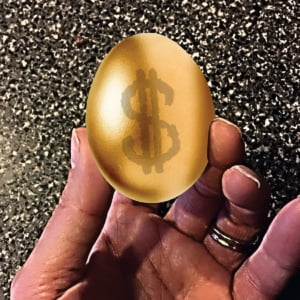It’s easy to keep your head down and process orders. That’s being productive. The job comes in; everyone handles their tasks, the job ships out, gets billed and paid. It’s like a dance. Step 1, 2, 3, and 4. Next job…ready, repeat. This dance doesn’t leave much room for working out of the fray and positioning yourself for some thoughtful pondering though. You are getting things completed after all. What’s the problem?
Along the way, hidden beneath the bustling activity and masked by accomplishment, is waste. Wasted time, wasted energy, wasted effort, wasted materials, wasted money. The funny thing is that you know all about the waste, but you choose to ignore it usually. You probably walk by or around it every day. Why? Well, orders have to ship. Asking questions can lead to uncovering difficult answers. It’s like cleaning a dirty spot. Once you rub off some dirt, now you have to clean the whole thing.
Probably the most powerful word in production management is “why”. How often are you using this word on a daily basis in your shop? Even more powerful is asking why multiple times. Part of the standard business Six Sigma analysis is asking “why” five times to peel away the layers of the challenge to determine the root cause of the problem. It’s very simple, but highly effective. Crazily enough, it’s called “Five Why” or “5W” for short. Here’s how to do it:
Write the problem down in a sentence. Jotting it down helps formalize the complete challenge, and gets your team to agree on exactly what the issue is on the outset. This is called the problem statement.
Here’s one for an example: “For job #12345 the screens will not register completely on press, due to the underbase screen peaking slightly out above and below the image. “
Now ask the five why’s to determine the root cause of the problem:
- Why won’t the screens for job #12345 register on press? – Because the underbase plate peaks out slightly above and below the image.
- Why does the image mis-register only on those two points? – Because the other four plates line up perfectly, it must be the underbase screen and not the art that is causing this problem. The art registers, so the screen used for the underbase has the issue.
- Why did the screen cause the problem, and not the art? – Because after examining the screen it was determined that it had unacceptable screen tension than standard. The low tension screen caused the image to print improperly on press and was the source of the problem.
- Why was a screen with low tension used for the job? – Because screens are being used and put back into circulation without proper retensioning or measuring.
- Why aren’t screens being retensioned or measured so higher quality screens are being used for jobs? – Because there isn’t a step in our screen room process to measure and resolve screen tension challenges.
What you are going to discover by asking more questions is the fundamental problem that is the basis for your shop’s pain. Determining the root cause of the problem will help you strengthen your shop, and focus your attention on the areas that need the most help. In our fictional example above, we went from the problem being focused with the press operator or possibly the artist, to the true cause of the issue in that there is poor screen room management. This could be any problem in your shop, not just focused on screens.
A word of caution here… Asking questions is not blaming. You shouldn’t ask five why questions and then go get into a screaming hissy fit with your screen room manager. The reason you should ask questions when confronted by a challenge is to discover a rational way to help resolve them. There is no room for defensive posturing in continuous improvement. In the example above, would it be too difficult to just have a newton meter by a table and measure screen tension as the screens are being worked through reclaiming? With a little training, and a modicum of management, a particular problem could be resolved by discovering and working through the problem as a team. Don’t finger point. Empower.
While “why” is a good question to always ask, what are other questions can you use in your shop? I’m a big fan of “what” and “how” also. They are forever linked. Let’s examine those power questions and find the reasons. “What” is a great word when thinking about your work order documentation, as in “what do we need to do for this order for it to be a success”? If you have the “what” handled, chances are you will have the “how” covered as well if you have some good training.
Your work order is basically your blueprint for achievement regarding the job as it moves through your shop. Just as an architect wouldn’t dream of letting a general contractor just construct any ol’ roof when constructing a building; you shouldn’t let your production staff make the decisions on how to decorate the garments in your shop either. Placement, colors, size and even shipping methods should all be predetermined long before the job reaches the floor. When your customer service or sales staff places the order in your system, it’s their job to build the order with complete and accurate information. If any other employee has to stop and ask “What thread color should I use?”, or “How many inches from the collar does the back location on a hoodie start?”, or “Can this go ground, it says it’s for an event?”…you know your front office staff hasn’t done a good job in order entry. Does this sound familiar? Get the “what” right, so your production folks can nail the “how”. Answer these “What” questions on your work order:
- What is the day the job has to leave the building? This helps all departments make scheduling decisions. Use a real date. Don’t pad with extra days. This is like the people that set their watches ahead ten minutes so they are never late. The trouble is that they are always late because they don’t have any discipline. It has nothing to do with the time on the watch, as they do the math in their head and constantly lie to themselves… ”Hey, I got ten more minutes!” Nobody has ten more minutes. Plan accordingly.
- What do you have to do for the image creation? Are you creating the art from scratch? Will the file be provided? Where is it and what is needed? Your art team or digitizer needs to know what to do and how to get started. Give them 100% of the details, including Pantone colors, thread colors, sizing, location, correctly spelled verbiage, and any other detail. If they get to choose, say that so they don’t loop around and ask you. Also, sometimes what the client doesn’t want on the art is just as important as what they do. Include more detail than you think they need. Your creative team will thank you. If your customers are constantly making revisions, then you aren’t providing enough detail. Check the level of changes your creative team makes to determine what’s needed on the front end. Be brave enough to ask questions.
- What are you decorating? You need exact quantities, by size and style. “We are getting 24 blue polo shirts in on Thursday” doesn’t cut it. How will your receiving team know they are getting the right inventory when it is delivered? The packing slip should match what’s in the system exactly. If your customer is one of those that drop off goods for you to decorate, have them create the packing slip before they come by and have your receiving team use that to check in the inventory. Train your customers to make your job easier. Use sku numbers, style descriptions, real quantities and tracking numbers. This “what” is all about avoiding expensive arguments later when two mediums turn up “missing”.
- What does production need to do? It all has to be spelled out on the work order. If you can’t write it, they can’t do it. Mental telepathy isn’t a job trait that many shops use for hiring decisions. Lack of quality production instructions is the number one time waster in shops, so spend a good deal of time in building these workflow steps so it functions perfectly. Think I’m kidding? Ask any production manager what is the number one reason a job stops in production. It’s all information based challenges. Two extra minutes typing on the work order, can save hours in production. It’s a no-brainer.
- What are the shipping details? If you have an order in the system that says “call for shipping”, you have a big problem on your hands. Your shipping details need to be built upon order entry. This includes all information, and can get very complex especially when dealing with fulfillment orders that use spreadsheets of addresses. Freight can get astronomically expensive if you make the wrong decisions, and very embarrassing if you miss customer event dates. Get everything in writing from your client, and understand completely what they want. It pays to double check. Send order acknowledgements that repeat back to the customer what your shop is going to do for the order, and make sure your ship date and in-hands date are front and center. Your production schedule must work backward from this, so knowing when the order has to leave the building is paramount to your success in scheduling.
Also, it doesn’t matter how many years your seasoned staff members have been working. Sure, they’ve been doing a fantastic job for twenty years; so they know what they are doing with their core tasks. Nobody is discounting that value. All it takes is them stubbornly doing it “their way”, instead of how your customer wanted it, for you to get into a very expensive situation. For example, an embroiderer who always chooses to use thread that is darker than the garment for tonal designs, or a printer that always prints three fingers down from the collar on the front. “That’s the way I’ve always done it” is a lazy excuse that translates to “It’s not my money that we’re spending to resolve the mistake, so I don’t give a hoot.”
A better method is to establish work order guidelines, and have production staff trained to read them like a blueprint. Simple standards clearly notated on approval forms, such as what thread color to use for a tonal embroidery order or printing the front print 3” down from the collar, can go a long way in establishing the expectations from your shop to your customer. If the customer doesn’t specify what they want, you give them your shop’s standard. If they want something different, or have their own idea, it will be reflected in your work order documents. All production has to do is follow what is outlined, and all expectations will be covered. Build this program, and train everyone in the shop to use it. Everyone! (That also means you Mr. or Mrs. Shop Owner)
It sounds easy, but in reality it takes a lot of communication, training and constant vigilance from your management to make sure that these steps are being followed and working perfectly. “What” and “How” only work if everyone is doing it. If Fred, the grizzled old manual printer, just does what he wants as he doesn’t want to change; then you are setting your shop up for a big problem. Fred has to be held accountable like everyone else. This brings us to “Who”.
“Who” is our last power question word, but probably the most critical. “Who” is all about the people in your shop. Do you have the right people working for you? Close your eyes and think about your shop and your staff.
Does everyone want to succeed, make the necessary changes for a better future, and can see things with an open mind? Or, do you have a Fred (or multiple Freds) working for you that constantly poo-poo’s any effort for change? Like a rusty old boat anchor, this person just drags behind you and forces your shop to work around their way of doing anything. That sucks. Fred might even acknowledge that there are better ways of handling things, but this guy never wants to adopt them and may even work towards sabotaging the effort just so he doesn’t have to do something different. Change is scary. What is scarier is having Fred drag your shop down, and you allowing it happen because confronting Fred and managing him is difficult. “Who” focuses on this problem, and the more you stop to think about your “who” the better off you will be in the long run. Get Fred to change, or get rid of Fred. Some closing thoughts on “Who”.
- Who in your shop can you count on to get the job completed in each department, no matter what? These are your rock stars. Treat them like royalty. Make sure they are happy. These are the folks with a great attitude; that stays late, work through lunch, or come in on a Saturday as that one order has to ship on Monday. When you count off your five best employees, each of these people is one of your fingers and the thumb. Model your hiring decisions based off of their character traits.
- Who can help you? Are you a one person shop? What happens if you have a really big order? Can you bring in someone to help? Fold shirts, clean screens, whatever. What if you have twelve autos or sixty heads of embroidery? Who can help you succeed? Probably a different scenario, but it’s the same idea. Who can you bring in to help you get better or get more accomplished?
- Who is your next manager, press operator or customer service person? Are you working on your bench-strength? What happens when one of your staff leaves, is sick, or goes on vacation? Work as usual, or is there a drop off in quality and volume? What are you doing about constructing your future? Just waiting with your fingers crossed that it will work out isn’t a good plan usually. If your company is growing, how are you going to scale-up with staffing? Give people time in the driver’s seat and the opportunity to grow.
- Who is on your deadwood list? Does your shop have a few people that you are constantly talking about and not in a positive manner? These are the folks that are making the mistakes, constantly late, or getting written-up. Let’s not even talk about how much time they suck up from your company’s managerial perspective. When you compare them to your shop’s rock stars, you wonder why they are even around. Actually, why do you have them around? Start training their replacement today.
- Who is your Fred? See above. Isn’t it about time you did something with that boat anchor?
Ok, your turn. What questions will make a difference in your shop?





